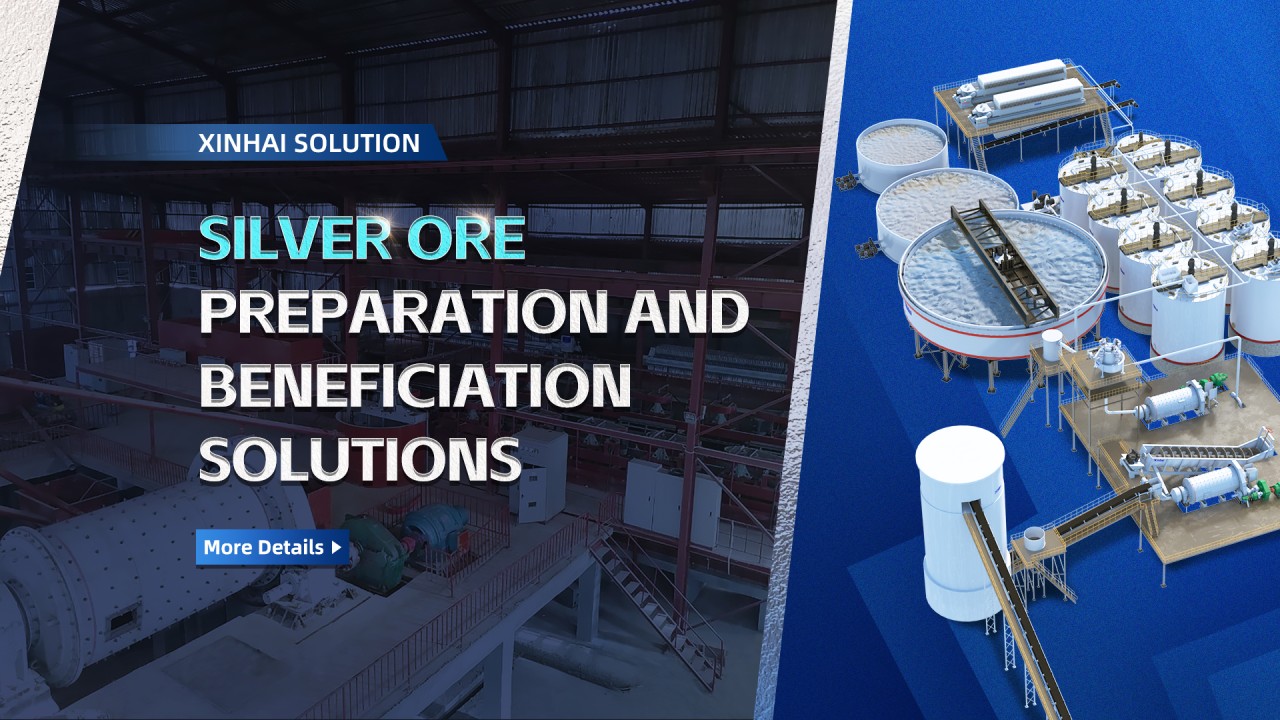
Silver Ore Preparation and Beneficiation Solutions
There are many kinds of silver minerals in nature, and the silver-containing minerals with production value include natural silver, gold-silver ore, argentite, dark red silver ore, horn silver ore, antimony-silver ore and so on. In ores, silver is often associated with lead-zinc ore, copper ore, gold ore, and limonite, and can be recovered together with other minerals. In this article, we will start with the mineral properties of silver ore and take you to understand the beneficiation process of silver ore.
The silver intercalation in silver-bearing minerals has a fine particle size and a relatively complex occurrence state. Therefore, grinding is very important in the preparation stage of the silver ore beneficiation process. Due to the complex composition of silver-bearing minerals, there are various beneficiation methods, including flotation method, cyanidation method, flotation-cyanidation method, gravity-flotation method and so on. In the following, we will describe the two aspects of the preparation stage and the beneficiation stage pf silver ore respectively.

1. Preparation Process of Silver Ore Beneficiation
In the preparation stage, grinding has a great influence on the recovery effect of silver ore. The number of grinding stages and grinding fineness need to be determined according to the distribution characteristics and occurrence state of silver ore, and the crystallization size of silver minerals is mostly between 5-10μm. During the period, the particle size of the main carrier is much coarser than that of the silver mineral itself, so it is not necessary to dissociate all the monomers of the silver mineral during the grinding stage, as long as the carrier is fully dissociated.
However, this situation is a relatively ideal condition, except for some silver minerals with copper, lead, zinc and other minerals as the carrier, and some silver minerals are dispersed in gangue minerals in irregular forms, or are fine grains of silver minerals. Embedded cloth, while the content of other sulfide minerals is low. For the recovery of these two types of silver minerals, the dissociation of fine-grained silver minerals can be achieved by increasing the fine grinding stage.

2. Beneficiation Process of Silver Ore
2.1 Silver Ore Flotation Process
In the beneficiation process of silver ore, flotation is commonly used to recover silver and its associated metals. The flotation process that can be chosen according to its ore characteristics includes preferential flotation, mixed flotation, partial preferential flotation, and partial mixed flotation, asynchronous flotation, distributed flotation, equipotential flotation, branch stream flotation, etc. In the process of silver ore flotation recovery, the factors that need to be paid attention to include the pH value of the pulp and the combination of reagents.
2.1.1 Adjustment of Ph Value of Silver Ore Slurry
In the flotation recovery of silver ore, it is necessary to avoid the use of some regulators, such as lime and cyanide, which can inhibit silver minerals. When using regulators such as sodium sulfite, sodium sulfate, and starch, attention should be paid to their dosage. Exceeding a certain amount is also not conducive to the flotation of silver minerals. The more suitable pH value of the slurry for flotation of silver minerals is between 6 and 8. Considering the conditions of comprehensive recovery, it should be adjusted according to the recovery of other minerals.
2.1.2 Appropriate Reagent Combination for Silver Ore Flotation
In addition to the grinding fineness and the pH value of the pulp, the appropriate chemical system is the key factor affecting the beneficiation index. The main collectors of silver and its carrier metal sulfide minerals include butyl ammonium black drug, aniline black drug, ethyl xanthate, Butyl xanthate, ethion, thiocarbamate, etc., using a mixed collector on the basis of a single collector can strengthen the flotation from the effect, and the commonly used collector combination includes butyl ammonium black drug and xanthate, aniline black medicine and xanthate, etc.

2.2 Cyanidation Process of Silver Ore
The cyanidation method is suitable for the symbiotic type of gold and silver minerals, and is also suitable for silver mines with reduced sulfide content, fine-grained silver minerals and quartz as the main gangue mineral. The leached silver minerals include silver oxide, elemental silver and silver sulfide. The principle is to use cyanide solution to dissolve silver minerals in precious solution, and then use zinc replacement method to extract it from silver. In this stage, factors that can affect silver recovery include the amount of sodium cyanide, the amount of oxygen or leaching aids, leaching time and so on.

2.3 Combined Process of Silver Ore
The gravity–flotation separation combined process is suitable for ores with high grade but uneven particle size and easy dissociation, which can improve the recovery rate of silver minerals and reduce certain beneficiation costs. The flotation-cyanidation combined process is suitable for recovering silver minerals embedded in gangue minerals, which can improve the recovery rate of silver ore.
All above is the key content about the silver ore preparation and beneficiation process. In actual production, it is also necessary to keep in mind that when formulating the beneficiation process, it is necessary to carry out the beneficiation test, determine the process flow in a scientific and reasonable way, and obtain the ideal beneficiation index.